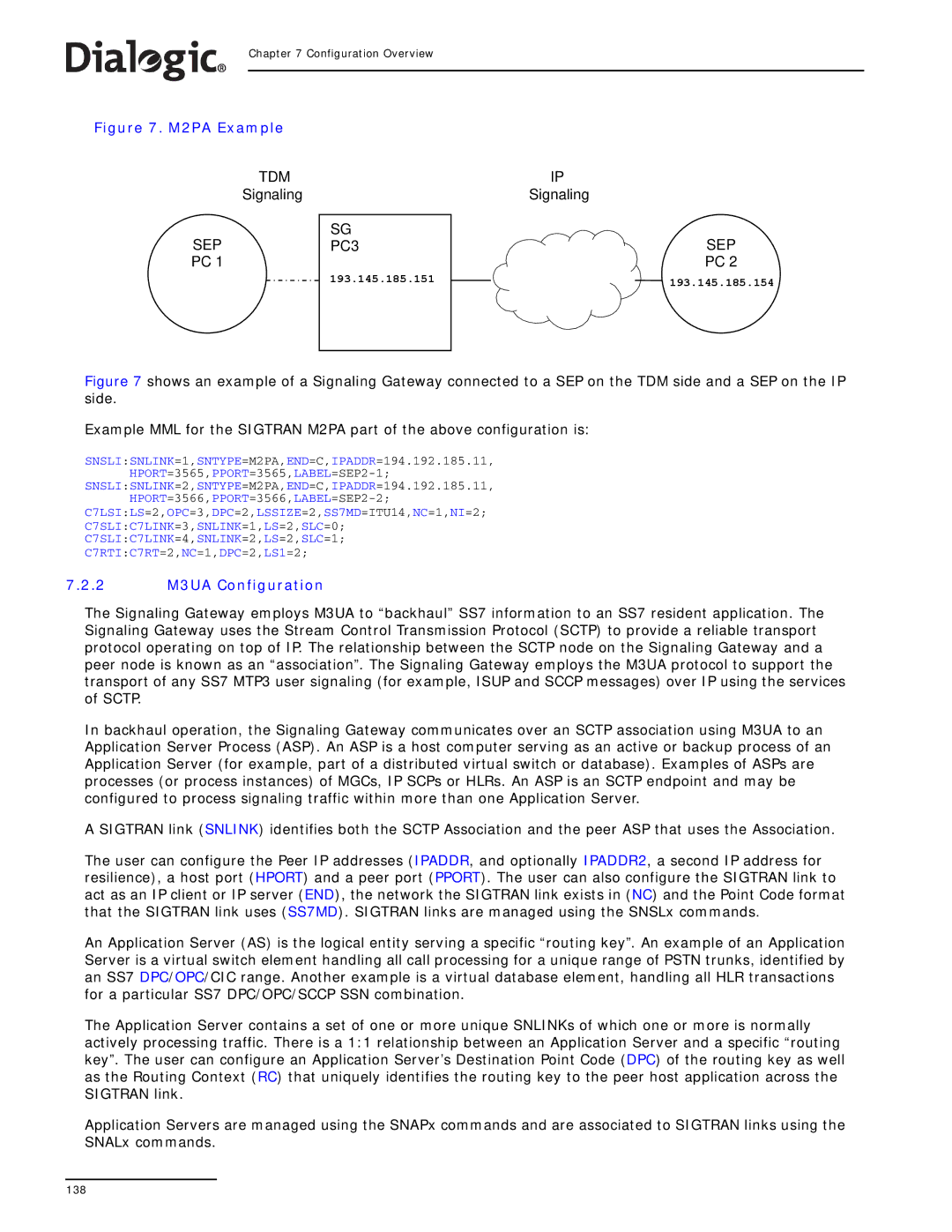
Chapter 7 Configuration Overview
Figure 7. M2PA Example
TDM
Signaling
SEP
PC 1
SG
PC3
193.145.185.151
IP
Signaling
SEP
PC 2
193.145.185.154
Figure 7 shows an example of a Signaling Gateway connected to a SEP on the TDM side and a SEP on the IP side.
Example MML for the SIGTRAN M2PA part of the above configuration is:
SNSLI:SNLINK=1,SNTYPE=M2PA,END=C,IPADDR=194.192.185.11,
SNSLI:SNLINK=2,SNTYPE=M2PA,END=C,IPADDR=194.192.185.11,
C7LSI:LS=2,OPC=3,DPC=2,LSSIZE=2,SS7MD=ITU14,NC=1,NI=2;
C7SLI:C7LINK=3,SNLINK=1,LS=2,SLC=0;
C7SLI:C7LINK=4,SNLINK=2,LS=2,SLC=1;
C7RTI:C7RT=2,NC=1,DPC=2,LS1=2;
7.2.2M3UA Configuration
The Signaling Gateway employs M3UA to “backhaul” SS7 information to an SS7 resident application. The Signaling Gateway uses the Stream Control Transmission Protocol (SCTP) to provide a reliable transport protocol operating on top of IP. The relationship between the SCTP node on the Signaling Gateway and a peer node is known as an “association”. The Signaling Gateway employs the M3UA protocol to support the transport of any SS7 MTP3 user signaling (for example, ISUP and SCCP messages) over IP using the services of SCTP.
In backhaul operation, the Signaling Gateway communicates over an SCTP association using M3UA to an Application Server Process (ASP). An ASP is a host computer serving as an active or backup process of an Application Server (for example, part of a distributed virtual switch or database). Examples of ASPs are processes (or process instances) of MGCs, IP SCPs or HLRs. An ASP is an SCTP endpoint and may be configured to process signaling traffic within more than one Application Server.
A SIGTRAN link (SNLINK) identifies both the SCTP Association and the peer ASP that uses the Association.
The user can configure the Peer IP addresses (IPADDR, and optionally IPADDR2, a second IP address for resilience), a host port (HPORT) and a peer port (PPORT). The user can also configure the SIGTRAN link to act as an IP client or IP server (END), the network the SIGTRAN link exists in (NC) and the Point Code format that the SIGTRAN link uses (SS7MD). SIGTRAN links are managed using the SNSLx commands.
An Application Server (AS) is the logical entity serving a specific “routing key”. An example of an Application Server is a virtual switch element handling all call processing for a unique range of PSTN trunks, identified by an SS7 DPC/OPC/CIC range. Another example is a virtual database element, handling all HLR transactions for a particular SS7 DPC/OPC/SCCP SSN combination.
The Application Server contains a set of one or more unique SNLINKs of which one or more is normally actively processing traffic. There is a 1:1 relationship between an Application Server and a specific “routing key”. The user can configure an Application Server’s Destination Point Code (DPC) of the routing key as well as the Routing Context (RC) that uniquely identifies the routing key to the peer host application across the SIGTRAN link.
Application Servers are managed using the SNAPx commands and are associated to SIGTRAN links using the SNALx commands.
138
